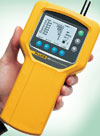

Monitoring and maintaining healthy and productive indoor environments is essential in modern commercial and industrial buildings.
Over the years, indoor air quality (IAQ) has been defined by a set of standards intended to promote occupant comfort and to avoid adverse health effects. Buildings should be dry, clean and properly ventilated. Occupant overcrowding, reduced ventilation and increased use of re-circulated air have a potential to increase concentration levels of pollutants. Indoor air contaminants including tobacco smoke, chemical fumes, combustion particles, biological contaminants and spores, can accumulate to levels that pose health and comfort problems if too little outdoor air enters the building. Pollutants can be circulated from portions of the building used for specialised purposes, such as restaurants, print shops, and production areas into offices in the same building. Carbon monoxide and other components of automobile exhaust can be drawn from underground parking garages through stairwells and elevator shafts into office spaces.
Sources of indoor pollution
Although the presence of such pollutants does not necessarily mean an indoor air quality problem exists, being aware of the type and number of potential sources is an important step toward assessing the air quality in the facility. Measurement is essential, whether checking for moisture, assessing dust levels, or ensuring proper airflow to maintain air quality. Active monitoring of conditions will promote a healthy, productive environment, and greatly reduce the number of occupant complaints. Measurements should include temperature, relative humidity, airborne particle concentrations, airflow and ventilation, as well as carbon dioxide and carbon monoxide levels.
Temperature and humidity
Temperature and humidity are important comfort factors, and failure to manage them can create problems, for example condensation and fungus growth. When a surface temperature is at or below the dew-point, condensation will form on walls, windows, cold water pipes and duct work causing potential damage and corrosion. Relative humidity must be kept low enough, for example around 40-45%, to ensure that surface temperatures do not approach dew-point levels. A meter such as the Fluke 971 provides accurate readings of relative humidity and dew-point temperatures.
Airflow and velocity
Velocity is a key parameter in evaluating airflow system performance. As part of the test and balancing of air distribution systems, velocity at grilles, registers, and diffusers should be measured. Airflow from registers and diffusers must create air patterns that evenly distribute and mix conditioned with ambient air while avoiding discomfort in the occupant zone. Since ventilation rates are based on occupancy, over-ventilation will occur when spaces are not at fully occupied. When the current ventilation level is more than required, energy is wasted. Periodic measurements allow determination of the appropriate level to maintain a comfortable environment. This enables cost savings through energy efficiency. The Fluke 922 is designed to measure pressure, velocity and flow simultaneously.
Carbon monoxide
Indoor combustion of fuels can be a source of increased concentrations of gases and particulates. The major by-product of combustion is carbon monoxide - a colourless, odourless poisonous gas with potentially serious health consequences given adequate exposure. Areas where combustion is occurring should be checked, along with occupied spaces adjacent to parking garages or warehouses. Simultaneous increases in both carbon dioxide and carbon monoxide can indicate ventilation system problems. The Fluke 975 measures carbon monoxide and carbon dioxide levels.
Conclusion
In response to the growing importance of air quality in industrial, commercial and residential buildings, Fluke offers a range of tools that monitor temperature, humidity, airflow and gas levels. These rugged and portable tools allow quick and easy analysis of indoor air quality and ensure efficient operation of heating, ventilation and airconditioning (HVAC) systems.
| Tel: | +27 10 595 1824 |
| Email: | [email protected] |
| www: | www.comtest.co.za |
| Articles: | More information and articles about Comtest |
© Technews Publishing (Pty) Ltd | All Rights Reserved